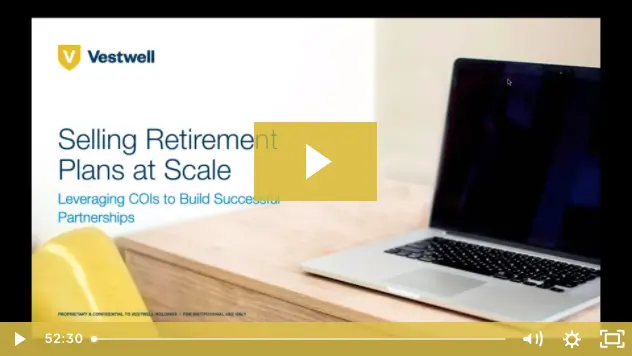
Selling Retirement Plans at Scale: Leveraging COIs to Build Successful Partnerships
The corporate retirement plan market has been transformed over the past 10 years, causing advisors to rethink opportunities for growth. Fee compression in the medium and large plan market has made the small plan market difficult to ignore. Yet, to distribute in the small plan market, advisors need highly scalable partnerships as well as technology that allows them to effectively advise on large volumes of plans. Given this environment, leveraging centers of influence (COIS) can prove incredibly valuable, especially with the right approach.
While there are many partnerships advisors commonly take advantage of (CPAs, lawyers, benefits brokers, etc.), there are also a number untapped networks that can become true strategic relationships. In particular, associations, banks/trusts, and payroll providers/PEOs have a great deal of potential because they a) have large membership communities to sell plans, b) offer mutual benefits to you, your partner, and their members, and c) have scalable distribution models. So, how can advisors make the most of these relationships?
Find the Right Partners
The hardest part might very well be identifying the right partners to approach. But if you break it down in a systematic way, you likely have many connections right in front of you.
- Start with your existing plans and wealth clients - Secret...You don’t have to go out and cold call. Instead, start with your with your own book of business and see which clients work with which associations, payroll providers, local banks, and other organizations.
- Demonstrate your expertise - Once you’ve identified a member that’s a mutual client, show them what you know. For example, if you’re working with a plan sponsor and want to connect with their payroll provider, outline all the ways that you’re currently supporting your mutual client, and how working together could benefit them (and the center of influence) even further.
- Be patient - These relationships take time to build. Don’t push yourself upon them, but rather continue to showcase all the ways in which this is good for both of you, especially through case studies with other partnerships.
Showcase What’s In It for Them
The first thing potential partners will want to know is “what’s in it for me?” Having a standardized 401(k) offering and, more importantly, a channel through which to offer it, can present a number of benefits.
- Increased member engagement - By creating a turnkey offering, members are able to take advantage of competitive 401(k) pricing along with an experienced plan advisor.
- Increased member retention - 401(k)s are very sticky, so setting up retirement plans for members/clients gives them an additional reason to stay while strengthening brand loyalty.
- New revenue stream - Your partners can make money from each plan, typically through a fixed or asset based fee, depending on the services provided.
Create the Right Offering
Coming to market with the right product is critical to success. This is not only about identifying the right partners, but also putting the right processes in place for scale.
- Develop, hire, or partner with experts - If you aren’t extremely comfortable in the retirement space - or frankly, even if you are! - it’s important to find the right partners to either fill gaps, or take on the responsibilities that aren’t efficient for you to manage. For example, given the liability in the retirement space, determine if you want to outsource investment or administrative fiduciary services to address governance concerns.
- Set up a repeatable model - To be successful with each partnership, you must have an offering that can be recreated several times. This doesn’t mean you can’t customize each plan, but focus on which features require the most flexibility and which ones can be standardized for better pricing and other efficiencies.
- Use the right TPA/recordkeeper - Leveraging the right TPA/recordkeeper is critical when creating your offering. You’ll want this partner to be someone who is able to create repeatable processes while offering excellent service. Also consider other features that your partners may find valuable, such as white labeling.
Customize Your Partnerships
It’s important to have a different approach for each of these partners, as each will have their own motivating factors and requirements.
Associations
With tens of thousands of associations nationwide, trade associations and local and state chambers of commerce provide great partnership opportunities. People look to these associations because of the connections they offer and the local benefits they provide. A 401(k) solution, especially with a trusted advisor, gives members an added benefit that will ultimately make them feel more connected to the group.
Useful Tactics for Getting in Front of Associations:
- Make sure you find associations with the right model. Look for partners that heavily market member benefits, or have member bases especially interested in the perks of group purchasing power.
- Focus on offering fiduciary services and managing plan governance protocols.
- Ensure you’re reaching out to the right contact to get your foot in the door; typically, this person is either the executive director or the strategic initiatives director.
Banks/Trusts
Local and regional banks are often looking for ways to differentiate themselves and strengthen brand loyalty with clients. Offering a 401(k) gives banks an added way to keep their clients’ money and economic decisions in a centralized place.
Useful Tactics for Getting in Front of Banks/Trusts:
- Look for banks that typically work with businesses rather than only wealth clients.
- Focus on brand loyalty, cross-selling, and retention and highlight how you make this easy for them and their clients (fiduciary oversight, investment selections, education, etc.)
- Banks are looking for a product that is a differentiator… find a way for them to leverage their brand, particularly through white labeling.
Payroll Providers/PEOs
Rather than building their own 401(k) offering, partnering with an advisor gives them a turnkey, all-in-one solution without the extensive investment of time and resources. Also, this relationship can be mutually beneficial since a strong relationship with a payroll provider or PEO means you’ll likely drive business back to them.
Useful Tactics for Getting in Front of Payroll Providers/PEOs:
- This is a quid pro quo relationship; they benefit by connecting with your clients and you benefit by them getting in front of theirs. Building mutual trust is key to making this successful.
- Be sure to partner with a recordkeeper that supports 360 integration for a truly seamless client experience.
Approach Centers of Influence Thoughtfully
Don’t try to boil the ocean. Instead, create COIs through a methodical and deliberate approach.
- Start with a pilot plan - Some partners may want proven success before fully trusting you with their clients. Start by supporting a few plans as a pilot so you can prove the value you’ll bring to the relationship.
- Don’t be overly prescriptive - Don’t get caught up in the plan details, such as if a MEP or SEP is a better solution. Clients care more about their brand and the value you’re bringing. Utilizing a turnkey, easy solution will resonate more with partners than discussing plan minutia up front.
- Understand your client - Every client is different. So understanding what is important to them can determine whether the partnership will flourish or if you’re left floundering. Make sure you align on things like who would own marketing, if the client is more concerned about retention or new business, and what other functional parts of their business would play a role in your relationship.
At the end of the day, there are many ways to go about creating a successful business. Building out your centers of influence is not only an efficient way to expand your practice, but also a great way to support clients in an effective, yet scalable way.








